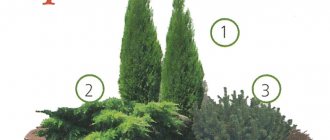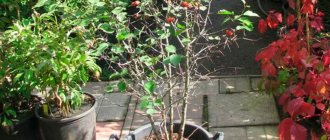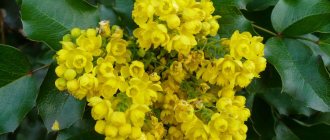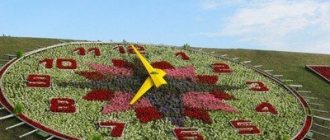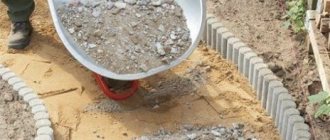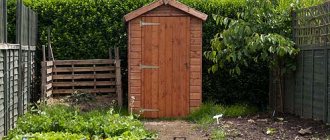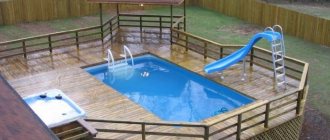Conifers are evergreen woody plants covered with needles, which from a botanical point of view are foliage (needle-shaped, lined or scaly). These include araucaria, spruce, kauri, cedar, cypress, larch, juniper, fir, sequoia, pine, yew, thuja and others.
Due to their unpretentiousness, year-round greenery and aesthetic appearance, they have long been actively used by site owners to create a unique landscape design. Decorative coniferous shrubs are especially popular - low, voluminous and pleasing to the eye.
Peculiarities
When deciding to plant coniferous shrubs on your site, it is useful to get acquainted with some of their features in advance in order to skillfully fit them into the landscape of your garden.
Tree or bush
In nature, most conifers are trees. They are distinguished by a spreading crown, a strong trunk, and a powerful root system. Such handsome giants are not particularly suitable for landscape design, because they create a lot of shadow and do not fit into the miniature size of the garden plot. The ball problem was solved in two ways.
Firstly, special ornamental coniferous shrubs, characterized by their small height, were bred. For example, no one will doubt that the mighty tall pine is a tree. However, look at its individual varieties - the bright Golden Glow lantern, the short and thick Gnome, the fluffy ball of Watereri. Also, no one will doubt that these are exactly shrubs - low, neat and incredibly stylish.
Decorative pine varieties:
Secondly, if the same tree is regularly pruned without allowing it to grow in height, it can begin to branch heavily and spread out in width, turning into a bush.
Advantages
Why are shrubby conifers so popular in landscape design? Why are many owners of country houses, garden plots and country houses so eager to acquire them? The advantages are obvious:
- hardy;
- unpretentious;
- needles that are expressive with their persistent and bright color;
- frost-resistant (most of them);
- allowing you to shape your silhouette as needed to create a pattern in a flowerbed;
- multifunctional;
- good for health (they release phytoncides into the air);
- drought-resistant;
- undemanding to soil type.
And, of course, evergreen shrubs are chosen to decorate plots because they delight the eye with their greenery all year round, enlivening them and taking part in creating flower beds of continuous flowering.
Functions
Coniferous bushes are simply irreplaceable in landscape design. They help create multi-style garden compositions and can become:
- a point of attraction on wide lawns;
- an essential element of rock gardens and rockeries;
- a classic shading background for flower beds of bright flowers;
- division into sectors and zones;
- decor for stones, buildings and fences;
- hedge;
- decorating flowerpots;
- good neighbors for some garden plants (for example, heather).
The main thing is to know exactly where to plant them and what to combine them with so that they become a decoration of the garden, and not a useless heap.
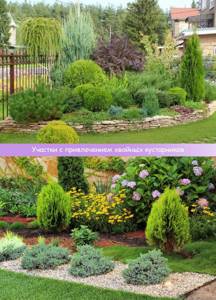
Accommodation Tips
To make a site with coniferous shrubs a real work of art, you can use the advice of landscape designers:
- if you create a flowerbed from only dwarf shrubs, it will fit perfectly into the design of a spacious lawn;
- Low-growing shrubs can be planted near the borders;
- for ponds on the site it would be good to create an edging with alternating conifers and deciduous weeping trees;
- plants with wide, variegated, curly leaves are planted surrounded by low coniferous bushes, which serve as an excellent shading background;
- low-growing varieties of pines are combined with creeping perennial plants and ground cover junipers;
- to create contrast, coniferous bushes are planted next to container nandinas and barberries;
- in alleys they look good when alternating with deciduous shrubs;
- junipers are used as hanging plants and in tandem with ferns.
Since coniferous bushes are easily modeled using pruning and take the desired silhouette and shape to fit into the created composition, they often become examples of real topiary art.
Valuable information and important tips
- Coniferous trees for landscape design are an excellent opportunity for original experiments. You can easily decorate your suburban area effectively. A huge number of unusual plant forms will make this easy to do. If you are convinced that caring for coniferous trees will require incredible effort from you, then you are mistaken;
- The most flexible trees are spruces, pines, junipers, yews and firs. If you want to plant cypresses and thujas, be careful. Different garden forms are very similar to each other, and only a true professional can figure out the final dimensions, level of winter hardiness and crown shape;
- Weeping, spherical, “colored” and other garden varieties of conifers (compared to natural forms) are more demanding of environmental conditions. They love light, and, as a rule, cannot boast of high winter hardiness;
- Representatives with a regular crown shape (pyramidal, spherical, conical) are asymmetrical with respect to the cardinal directions. On the northern side, such trees have fewer and shorter branches than on the southern side;
- When building a certain composition from coniferous plants, remember that trees grow at different speeds. That is why growth rate is an important criterion that must be taken into account when selecting “roommates”;
- Most conifers prefer breathable and moist soil. When planting on heavy clay soil, you should dig a hole (20 cm) and lay pebbles, crushed stone, and broken bricks on the bottom;
- Many plants do not tolerate dry soil and air well. Thus, watering one tree should take at least 1 bucket (ideally 2). On hot days it is recommended to spray;
- Trees with silver, golden, bronze, blue colors in the shade may lose the natural color of their needles;
- Young plants grow well in the shade, however, if in the future they do not have enough sunlight, they will die. For the winter, it is better to cover the young animals with spruce branches and then with snow;
You also need to know how to buy seedlings. Never buy plants with bare roots - they will die. The roots should be protected with clods of earth and packed. Buy specimens with fresh needle growth - the tips should be elastic and flexible. It is better to do this in the spring, and not in the fall, as many people think.
When arranging your garden, do not forget about coniferous plants. These evergreen friends can transform your summer cottage beyond recognition - making it not only incredibly beautiful, but also environmentally friendly!
Care
Disembarkation
This is the most difficult thing. Coniferous shrubs, despite their small height, have deep roots. Therefore, replanting them is incredibly troublesome. So you need to immediately wisely choose a place where the plant will be as comfortable as possible, so that later you don’t throw it from one corner to another. Advice from landscape designers will help you do it right:
- buy seedlings only in specialized stores;
- the breed and variety must be indicated on the package (label);
- the needles should be juicy and green, no yellowness or dryness;
- on the roots - the obligatory lump of earth;
- if these are decorative shrub varieties of larch and pine, you need the most sunny place, all others - in partial shade, and juniper is especially sensitive to ultraviolet radiation, so it should be planted in shady places;
- what the soil should be like: not clayey, with deep groundwater;
- humidified air is useful, therefore, if there is a pond on the site, this is the most suitable place;
- Possible planting time: spring, autumn (no later than September).
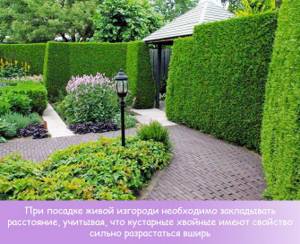
Landing technology:
- Dig a hole, the diameter of which should be twice the size of the root ball of the seedling.
- Mix the soil with compost and fill half the hole.
- Plant a seedling. Sprinkle with fertilized soil so that the root collar is not underneath it.
- Water generously.
Breeding varieties may have nuances when planting. Therefore, when choosing exotic and unusual species, you should always ask whether there are any special recommendations for caring for them.
On topic: Recommendations for planting coniferous plants
Watering
Coniferous shrubs themselves do not require regular and abundant watering. It is not for nothing that they are considered one of the most unpretentious garden plants. There are only a number of cases when they especially need it:
- newly transplanted;
- young;
- in the absence of rain, when the soil is completely dry.
In autumn, about 2 weeks before the first frost, abundant watering is also required.
Top dressing
The soil needs to be fertilized about once a month. This should be done more often if the plants:
- weakened;
- painful;
- young;
- belong to exotic varieties;
- transplanted;
- short.
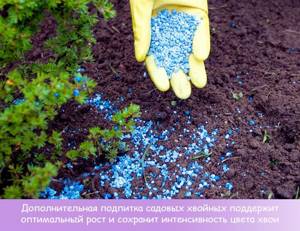
For fertilizing, you can use natural fertilizers (manure, turf soil, complex compost, leaf humus, bird droppings, peat). Or buy store-bought ones with a mark on the package “For conifers.” It can be:
- Bona Forte;
- Compo;
- Fertika;
- Florovit;
- Green Needlt;
- Pokon;
- Reasi;
- Aqua Agricola;
- Hera;
- Fusco.
Feeding should be done especially carefully in the fall. This must be done no later than a month before the first frost. Otherwise, the plants will devote all their energy to intensive growth and will find themselves completely exhausted for the winter.
On topic: Home and store fertilizers for conifers
Trimming
Mandatory pruning of coniferous shrubs is carried out immediately after winter. It is necessary to remove all frost-damaged, broken and dried branches so that they do not interfere with the growth of new ones. During the summer, it is required by those plants that need to draw a particular silhouette or shape. For example, ball- and cone-shaped ones are trimmed every 2 weeks to give them the appropriate look. In the fall, this is no longer worth doing, because the dense branched crown protects them from frost.
Wintering
Mulching will help plants survive the winter easier. Therefore, before frost, be sure to sprinkle the soil around them with wood chips or sawdust. The thickness of the layer is approximately 5 cm. With such insulation, the earth breathes, providing the roots with a sufficient amount of oxygen, and at the same time it will not freeze in the event of severe frosts.
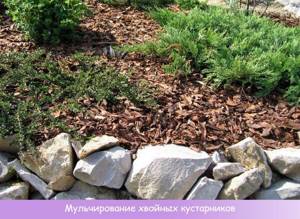
What else needs to be done to make wintering easier for the bushes:
- water thoroughly 2 weeks before frost;
- tie spherical and pyramidal shapes so that the branches do not fall apart with snow;
- in winter, shake off large drifts of snow from the branches so that they do not break off - especially since the bushes have thin and fragile ones;
- in February, it will be necessary to build an awning over the bush, which will protect it from blizzards, blizzards and early bright sun rays - in March they can burn the weakened needles;
- if conifers grow on an alpine hill, you need to build a snow-retention shield on the leeward side (for example, from a vine);
- put low-growing bushes that have stood in flowerpots, pots and containers all summer on a glassed-in balcony or terrace for the winter.
On topic: How and how to treat coniferous plants
How to plant coniferous trees correctly?
Anyone can plant coniferous trees for their garden. The main thing is to know some secrets and take into account some nuances.
The best time for planting is autumn. The depth of the hole should not exceed 80 cm. The distance between plants should vary from 80 to 150 cm. In order for young plantings to take root, add clay and sand to the soil. Within 6 months after planting, the soil should be fed with mineral fertilizers. In summer, pay great attention to watering. On average, at least 6 waterings should be done per season. A total of about 20 liters of water (per plant) will be required.
Do you want the crown to be as thick as possible? In the spring, carefully cut the annual shoots by a third. Take care of your trees in winter. Cover them with craft paper or spruce branches. Rapid growth is facilitated by loosening the soil near the trunk.
Kinds
There are different types of coniferous shrubs that can be used for the garden. Here you will find several classifications and names of plants.
Depending on height
Short:
- mountain pine Golden Glow (Golden Glow) - 0.5 m;
- common spruce Maxwellii (Maxwelli) - 100 cm;
- juniper horizontal Blue Chip (Blue Chip) - 35 cm;
- blunt-leaved cypress Aurora (Aurora) - 65 cm;
- microbiota cross-paired Jakobsen (Jacobsen) - 70 cm.
Medium height:
- mountain pine Gnom (Gnome) - 1 m;
- prickly spruce Glauca Globosa (Glauca Globosa) - reaches 3 m by 30 years;
- Chinese juniper Mint Julep (Mint Julep) - 2 m;
- blunt-leaved cypress Rashahiba (Rashahiba) - 2 m;
- yew berry Elegantissima (Elegantissima) - 2 m.
Tall:
- Scots pine Watereri (Wateri) - 4 m;
- blunt-leaved cypress Draht (Draht) - 3 m;
- yew berry Hicksii (Hixie) - 4.5 m;
- cryptomeria japonica Elegans Viridis (Elegans Viridis) - 4 m.
If you need to decorate a border or highlight a garden path, it is better to take a low-growing coniferous shrub. Medium-sized ones are suitable for decorating flower beds and more serious flower arrangements. Tall ones are used in landscape design as hedges or points to attract attention in spacious lawns.
Depending on sunlight tolerance
Shade-loving and shade-tolerant (sciophytes and scioheliophytes):
- fir;
- spruce;
- cedar, etc.
Photophilous (heliophytes):
- pine;
- larch.
Most coniferous shrubs are shade-loving, grow well in the shade and do not require a constant stream of ultraviolet light. Only two species are classified as light-loving: pine and larch. So it is better to plant their decorative varieties in sunny areas. They can be recognized by their light colored needles. All the rest are dark coniferous.
Depending on the shape
Pyramidal and round shrubs look most beautiful in the garden.
Globular:
- mountain pine Pumilio;
- black pine Spilberg;
- Thuja occidentalis Little Gem, Globosa, Hoseri, Mirjam, Mr. Bowling Ball, Teddy, Tiny Tim or Danica;
- juniper: Chinese Echiniformis, scaly Blue Star, scaly Floreant, common Berkshire.
Pyramidal:
- rock junipers: Blue Arrow (blue pencil), Skyrocket, Moonglow;
- common junipers: Hibernica, Arnold, Compressa, Sentinel;
- Chinese juniper Keteleeri;
- yew berry Fastigiata, Fastigiata Aurea;
- Thuja occidentalis Bobeck's Tower, Holmstrup, Degroot's Spire;
- single color fir Fagerhult.
Many coniferous shrubs can be given any shape using decorative pruning.
Depending on brightness
When organizing flower arrangements and flower beds on your site, you should consider how shrubby conifers will fit into them in terms of their color.
Firstly, as already mentioned, there are two light-coniferous plants - larch and pine. The rest are dark coniferous.
Secondly, many are interested in flowering coniferous shrubs, although this name is not entirely correct from a scientific point of view. Cones are taken for flowering in this type of plant. For some, they are so beautiful and have an unusual shade that they are as close to flowers as possible. First of all, these include juniper varieties. Among them you can find a very different palette - from bright yellow to blue.
Thirdly, in the second half of summer, closer to autumn, some conifers form fruits on their branches that attract attention with their bright color. For example, a well-known shrub with red berries is the berry yew. Or the same juniper, whose flowers turn into small bluish fruits. Such options will fit perfectly into flower beds of continuous flowering.
Conifers for the garden
Almost all coniferous plants are suitable for creating artificial landscapes. But which species are suitable for designing a particular territory depends on the area of the site, the degree of its shading, terrain features and soil type. The design of the garden should also be taken into account when selecting vegetation, but it should be noted that conifers look natural in any landscape style.
Pine
From the pine family, all types of spruce, pine and fir are used in ornamental gardening. From natural conditions, medium-sized, and less often tall, trees have moved into gardens and are successfully cultivated, and dwarf coniferous plants have been bred through selection.
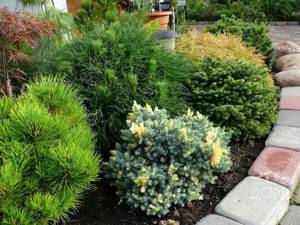
Pines and spruces thrive on sandy and rocky soils, but on loams and black soils they require high-quality soil drainage, since they do not tolerate stagnant moisture.
Fir is one of the most beautiful coniferous species. It has a property not inherent in other coniferous plants - it reproduces by layering. Having dug up the young shoots, they can be replanted and in a few years you will get a full-fledged plant. Fir grows well on sandy and rocky soil, loam and black soil.

Korean fir diamond
Larch also has its own “zest” - unlike its coniferous relatives, it sheds its needles for the winter, just as deciduous trees shed their leaves. In autumn, before shedding, larch needles change color from green to various shades of yellow. Like all pine trees, the plant is unpretentious and not capricious.
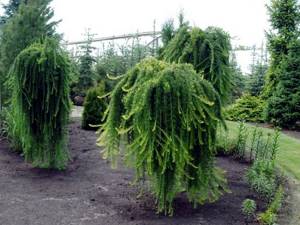
Cypress
The main representative of the cypress family, the cypress is a tall tree with a narrow pyramidal crown. The plant is not frost-resistant, so it is grown in regions with mild winters. In addition, cypress is sensitive to gas pollution in city streets and does not tolerate crowded plantings, which also limits its scope. Where climatic conditions allow the use of cypress, it is included in the mountain landscape with multi-level buildings, group plantings are created and framed alleys.

Large-fruited cypress Goldcrest
The most striking and frequently used representative of cypress trees in decorative landscaping is juniper. The genus includes low-growing and large trees, reaching a height of 15 m, as well as shrubs of various shapes and habit.
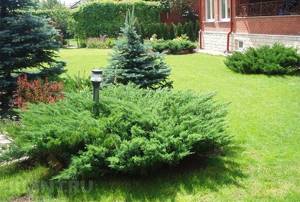
Thujas are coniferous evergreen trees; most species are frost-resistant and can easily tolerate pruning. They are equally easy to propagate by seed and cuttings. The variety of species and varieties makes it possible to use thuja in almost any type of planting: groups, tapeworms, hedges, creating a background, alleys and even borders.
Yew
In the landscaping of summer cottages, yew and torreya are least often used, which, compared to other coniferous plants, are distinguished by their unusual shade tolerance. A distinctive feature of yew is the absence of any odor. It tolerates cutting well, so it is often used to create hedges.
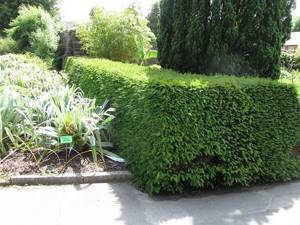
It is easier to propagate by cuttings, since long-term stratification is required for seeds to germinate. But it should be noted that even an adult plant can tolerate transplantation without complications.
Warning! The berries, needles and other above-ground parts of the yew are poisonous, so you need to be careful when caring for the plant.
Unlike yew, torreya exudes a specific smell that not everyone likes. This is a low evergreen tree with a pyramidal crown and hard linear leaves up to 8 cm long. The plant is very unpretentious and frost-resistant, and can produce root shoots, which are used for propagation.
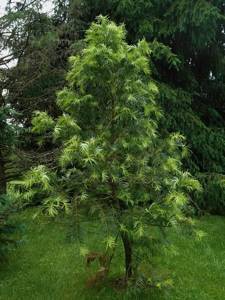
Review
A short review will help you make your choice. A brief description of the most suitable coniferous shrubs for the garden will give you an idea of how organically they will look in flower and garden compositions.
Juniper Cossack Mas (Mas)

Crown: funnel-shaped, widely spread, occupies an area of up to 8 m in diameter.
Height: no more than 2 m.
Needles: bluish-green, purple in winter.
Where to plant: in open spaces or in partial shade. Soil that is saline and has close-lying groundwater is not suitable.
Purpose:
- for a flower bed of continuous flowering;
- for hedges (borders).
Korean fir Silberlocke (Silberlock)
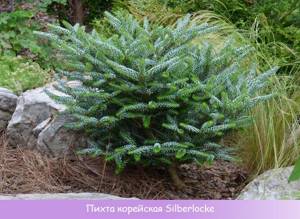
Crown: in the lower part it can grow up to 3 m.
Height: no more than 4.5 m.
Needles: soft, gray-blue, gray.
Where to plant: in a well-lit place.
Purpose:
- if planted in straight lines, you will get an alley along the perimeter of the path;
- can mark the boundaries of a rockery in a Japanese garden;
- greens a flowerbed of continuous flowering in winter;
- decorates an alpine hill or lawn;
- is a tapeworm in the middle of flower beds and ornamental lawns.
Pairs well with barberry, spirea, red maple, thuja and juniper.
Some plot owners specifically look for conifers with soft needles so as not to prick themselves when caring for them or if there are often small children in the garden. Larch and fir in this case will be ideal options. And the Silberlocke variety can rightfully be considered one of the champions in this criterion.
Common juniper Depressa Aurea (Depressa Aurea)
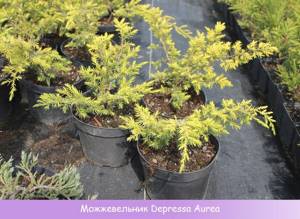
Crown: grows up to 2 m.
Height: no more than half a meter. The growth rate is 15 cm per year.
Needles: golden-yellow in summer, brown in winter, becoming yellow-brown over the years.
Where to plant: in moderately moist soils with an acidic or alkaline reaction, sandy loam. Loves partial shade.
Purpose:
- rocky and heather gardens;
- rockeries;
- terraces;
- compositions with shrubs and perennial herbs;
- juniper lawns as ground cover.
A beautiful creeping shrub in any garden will attract attention with its delicate light green needles.
Yew berry Fastigiata (Fastigiata)
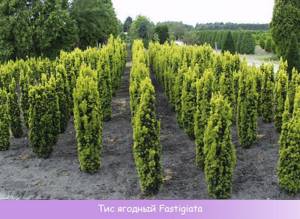
Crown (quite narrow): the lower diameter can grow up to 2.5 m.
Height: up to 6 m, but grows extremely slowly.
Needles: dark green. The branches are arranged in a spiral. The bush bears fruit regularly. The bright red berries contrast favorably with the dark needles.
Where to plant: soil mixture of sand, turf and peat (proportions 2/3/2). Increased soil acidity is not recommended.
Purpose: for hedges.
Mountain pine Pumilio (Pumilio)
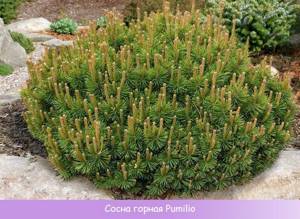
Crown: grows up to 3 m wide.
Height: no more than 1.5 m (maximum).
Needles: dark green, more often short than long, collected in bunches of 2 needles. It looks like a pillow - a flat-rounded shrub, widely spread, with dense branches. The cones are also very beautiful, ovoid, dark brown.
Where to plant: tolerates light and shade equally well. It is absolutely not demanding on the soil.
Canadian spruce
All types of Canadian spruce have the ability to blend harmoniously into gardens of a variety of styles. This is facilitated by their regular and strong crowns.
Daisy White
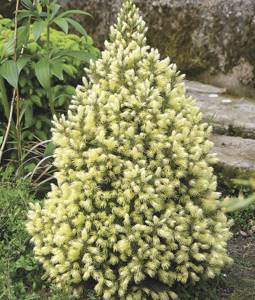
An elegant, uniquely beautiful coniferous tree with a cone-shaped crown. Young growths are creamy white, then turn green. Variegated coloring appears in well-lit areas. An ideal conifer for owners of small plots.
Konika

Cone-shaped spruce with a thick, dense crown, characterized by slow annual growth. It grows two to three meters high.
Echiniformis
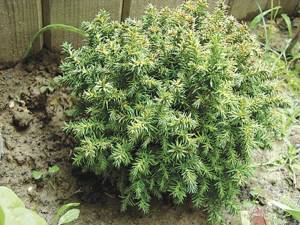
Small spherical spruce. It grows very slowly and until the age of ten grows in diameter to only 30-50 centimeters.
Rainbow End

Dwarf cone-shaped spruce. Despite the two-time summer growth, at the age of ten it grows up to one meter in height. Valued for its decorative needles - summer young shoots are yellowish in color.
Sanders Blue

A small tree, up to one meter high. It is distinguished by a silvery-bluish tint of needles.
